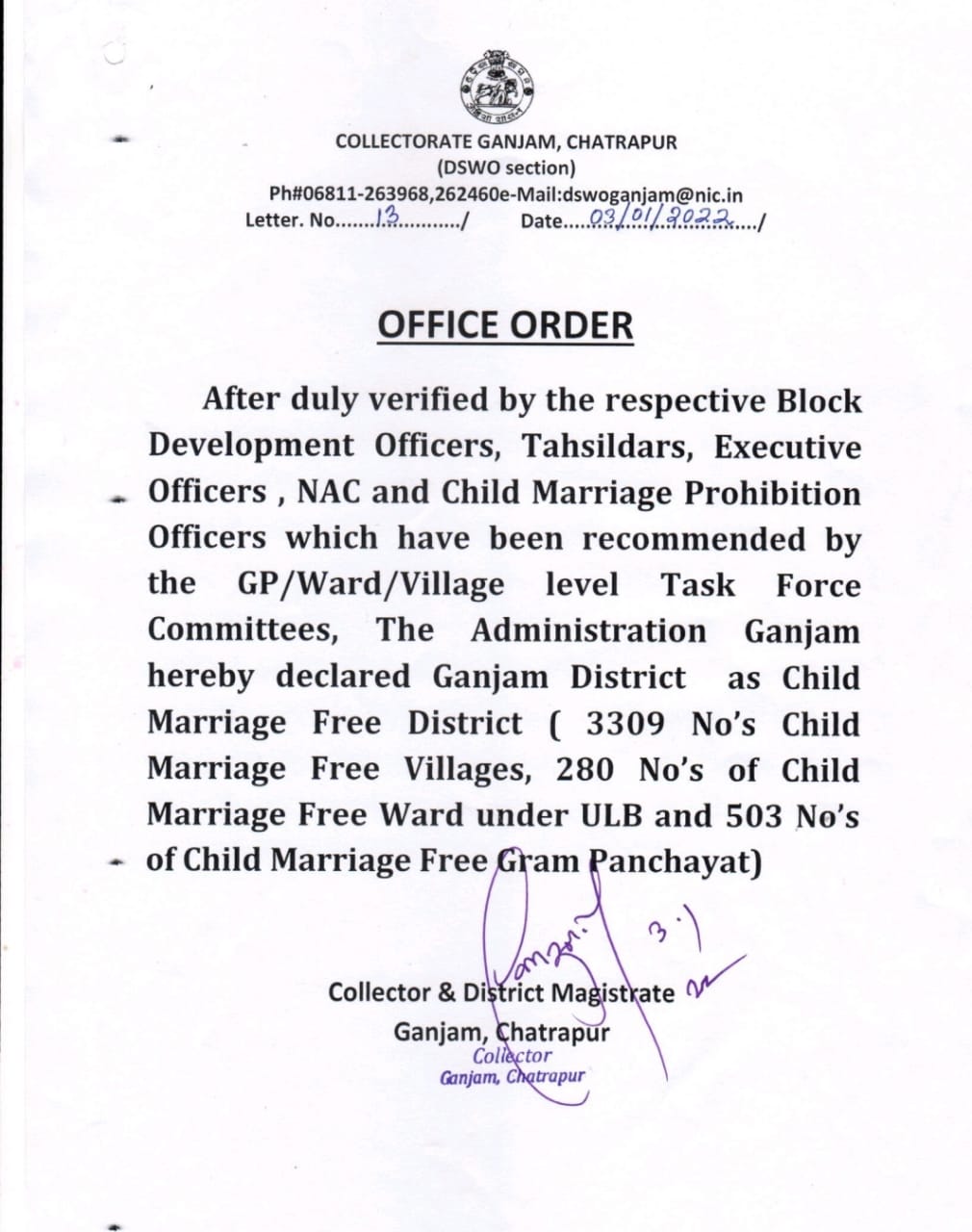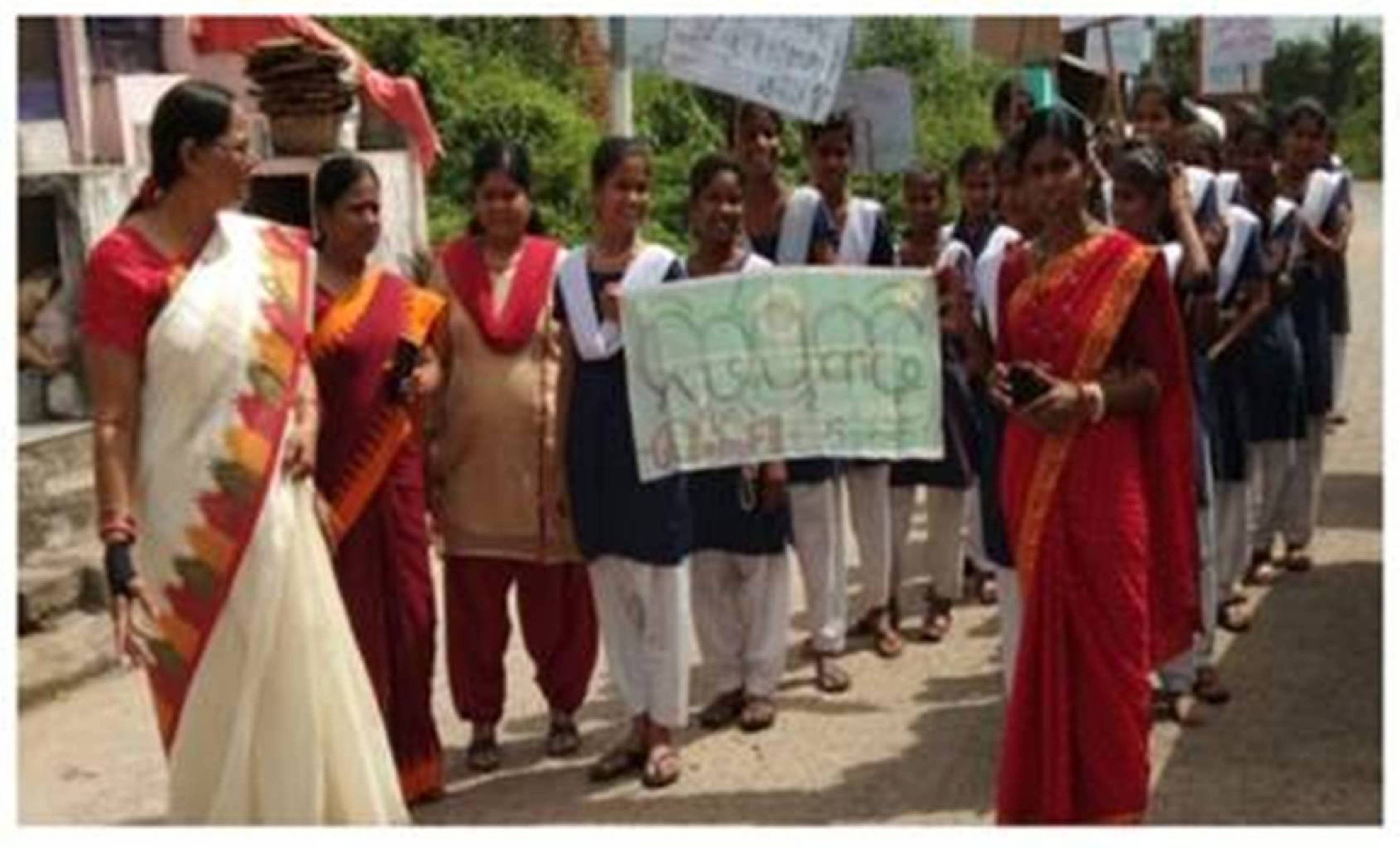Bhubaneswar
(Odisha), January 11: In 2019, the
district administration in Odisha’s Ganjam district had launched the ‘Nirbhaya Kadhi’
(Fearless Bud) campaign to address incidents of child marriage in the region.
In a span of two years, the district has achieved the status of being ‘Child
Marriage Free.’ An office order was released on January 3, 2022 by the
Collector, confirming the tag.
"After duly verified by the respective Block Development Officers, Tehasildars, Executive Officers, NAC and Child Marriage Prohibition Officers which have been recommended by the GP/Ward/Village level Task Force committees, Ganjam Administration declared the district as a child marriage free district,” the order signed by Collector Vijay Amruta Kulange stated.

According
to the National Family Health Survey (NFHS) - 4 report, Ganjam recorded 29.8
percent child marriages, higher than the state average of 21.3 percentage. The
cases came down by 7.5 percentage in the subsequent survey NFHS-5 for the year
2019-2021.
“The
efforts to end child marriages had started long back, but the Nirbhaya Kadhi
campaign ensured a more planned implementation. The campaign was driven by the
administration and several organisations, and local people were given
responsibilities to address the issue,” said Debabrat Mahunta of Action Aid, an
organisation which played a major role in the initiative along with UNICEF and the
government.
The Campaign
To address the child marriage issue, the campaign first identified
local priests and other learned elderly members in the village, who enjoyed a
respectable status. A sensitisation programme was first launched for them, highlighting
the social and legal consequences of early marriage. After gaining the trust
and consent of these elders, the programme started awareness campaigns at the
village level, where young girls were given proper counselling. A sum of Rs
5000 was also promised to the informants of child marriage. It has now been
increased to Rs 50,000. After the initial awareness drive, a village task force
committee was formed which was made to take an oath to prevent child marriages
in their area.
A major thrust of the Nirbhaya Kadhi campaign was to stop
adolescent girl students from dropping out from school. The schools were
directed to inform the administration if any girl child in the age group of 12
to 18 years remained absent from classes for more than five days at a stretch.
This was another way to monitor child marriage cases.
There
are no set guidelines to declare a region as ‘Child Marriage Free.’ In Ganjam,
the declaration was made primarily on two aspects – a ‘no marriage resolution’
was to be taken at the village and block level and awareness programmes about
the adverse effects of child marriage were to be held at regular intervals.
UNICEF
has laid down seven parameters for awarding Child Marriage Free Village. It
includes functioning of a task force in the village, availability of database
of adolescent with task force, no child marriages in the last one year,
villagers are aware about Prohibition of Child Marriage Act (PCMA), a maintained
‘meeting resolution register,’ representation submission by the villagers to
declare village as ‘Child Marriage Free’ and declaration by the village temple
as Child Marriage Free Zone.
In
2020-21, Ganjam recorded 48,383 marriages in total with 26 incidents of child
marriages which were addressed by the Child Welfare Committees. The office
order was passed only after villagers sent a resolution to the block level
which was verified and communicated to the district level.
Though
the ‘Nirbhaya Kadhi’ campaign is solely meant for Ganjam district, various
initiatives are taking place in other parts of the state to prevent child
marriage. The state has set a target of 2030 to completely end child marriage. In
Deogarh district, 370 villages were declared ‘Child Marriage Free’ last year. Rugudipalli
village in Subarnapur district was the first village in Odisha to get the tag. To
confirm the legal age at the time of marriages, a valid document proof like an
Aadhar card or a voter id card is mandatory.
Raising the Legal Age
Even
as Odisha is looking to end early marriage among children, the raising of legal
marriage age of girls has become a challenge. Last week, the Odisha State
Committee for Protection of Child Rights (OSCPCR) wrote a letter to the Chairperson
of the Parliamentary Standing Committee opposing bill to raise the legal age of
marriage of girls.
“Change
of legislation in isolation will never be able to stop child marriage, unless
there is a socio behavioural change among the parents and the community.
Factors like distress and poverty, patriarchal norms and practice, lack of
opportunity for schooling, unemployment, etc are still contributing to a large
extent for the prevalence of child marriage. There is also a need to strengthen
families by providing appropriate livelihood opportunity,” stated the letter
signed by Sandhya bati Pradhan, Chairperson, OSCPCR to the Parliamentary
Standing Committee.
A
letter has also been sent to Anubhav Mohanty, Member of Parliament from
Kendrapara constituency in Odisha, who is a member of the Parliamentary
Committee.

